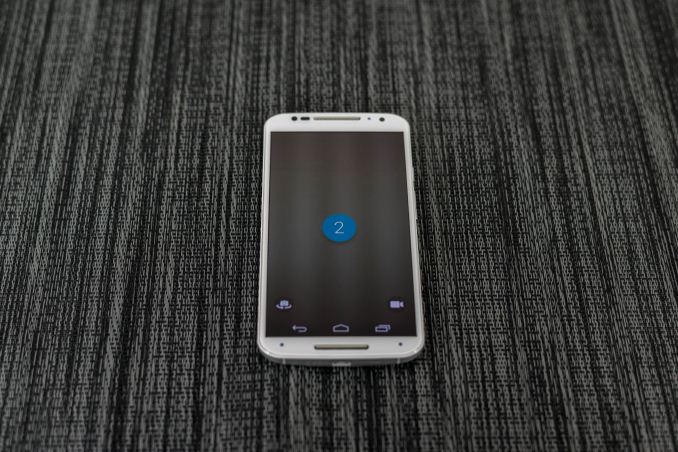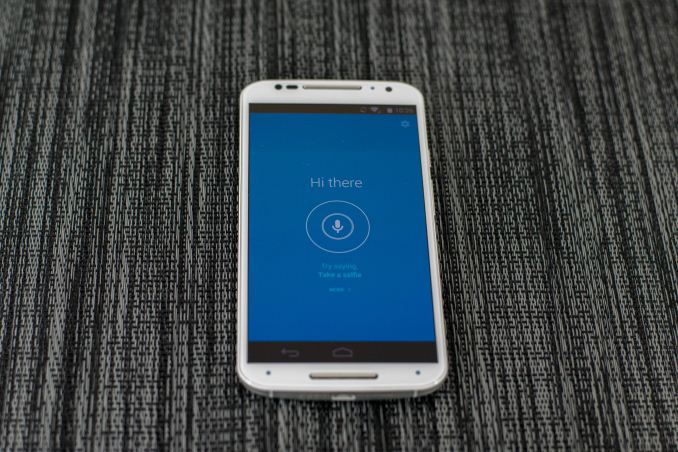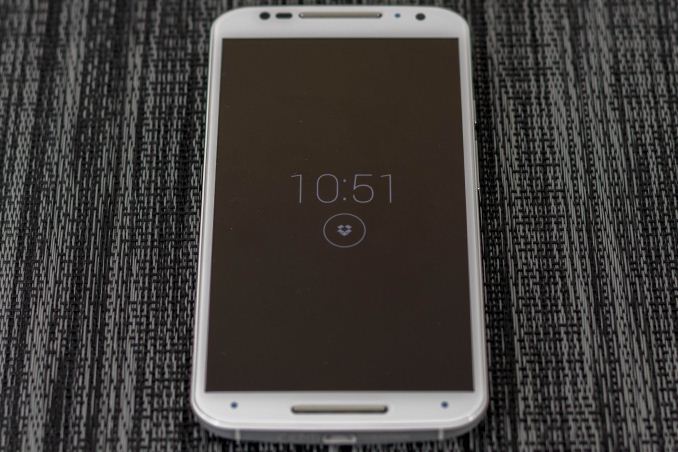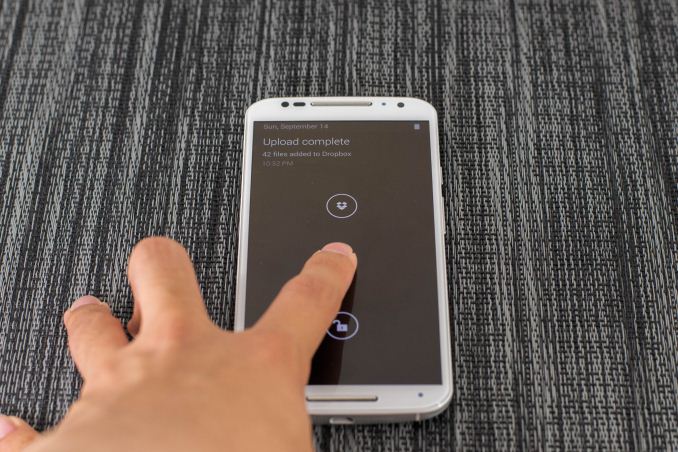The New Motorola Moto X (2nd Gen) Review
by Joshua Ho on September 17, 2014 9:00 AM EST- Posted in
- Smartphones
- Motorola
- Android
- Mobile
Moto Voice
One of the highlight features of the previous Moto X was Touchless Control, and Motorola spent a great deal of time trying to empahsize improvements in this feature with at the launch event. For those unfamiliar with Touchless Control in the previous Moto X, I would reference Brian's Moto X review. For those that don't want to read another review, the quick explanation is that Moto Voice acts as a voice command system, similar to Siri but with integration into Google Now and it works purely based on voice instead of long pressing a home button or a swipe gesture on the navigation keys. With the new Moto X, not too much changes, but there are some key features added. First, we see the ability to assign new keywords other than “Ok Google Now”, which is nice. I’m not really sure how this is enabled, as based upon some digging Motorola is still using a TI C55x DSP to enable low power hotword detection.
For the most part, other than this change I don’t really see a major step forward in functionality, although I’m sure that some will see a great deal of benefit from the voice-enabled selfie feature, which automatically opens the camera app with the countdown as seen above. Voice control continues to be an area where I’m unsure that there’s functionality to be had all the time. For the most part, I only seem to use voice control in situations where my hands are unable to manipulate the phone, which basically means when I’m driving or walking. For better or worse though, this is an area where wearables are much more effective. For example, it’s quick and easy to raise my wrist and ask for navigation to an event while driving compared to trying to reach into my pocket and carefully pull out my phone without dropping it under the seat. While explaining how this happens is a long story, the critical point here is that Moto Voice doesn’t really have a killer use case that isn’t done better by something else.
At any rate, the user interface also changes with the new Moto X. We see a great deal more color and a generally friendlier UI compared to the rather dark theme we saw before. Motorola seems to be following Android UI trends in general with this move, although it will affect battery life on AMOLED panels. The setup process is relatively simple, although there’s definitely a need for a quiet room. Even mild amounts of background noise will complicate setup. I also noticed that differing aural environments could alter the responsiveness of Moto Voice, although this could be due to the function turning itself on and off due to a bug in the ROM.
Moto Display
While Moto Voice is a bit limited in usability, Moto Display continues to be a great feature. For those that are unfamiliar with how Active Display worked in the previous Moto X, I would reference Brian's Moto X review again. For those that aren't familiar with Moto Display, this is effectively a low power mode in the Moto X that will display notifications and the time that also acts as a lockscreen. In order to support this low power mode, it isn't actually a part of Android OS and is programmed by a microcontroller so it isn't possible to take a screenshot of Moto Display.
While what we saw in the original Moto X was fantastic, the new Moto X takes things further by adding Moto Actions. While one part of Moto Actions is waving to silence alarms and phone calls, the other aspect allows for proximity to turn on Moto Display. This means that there’s no longer a need to shake the table or wiggle the phone in order to glance at notifications. While the original Moto X had a similar feature, it relied on the proximity sensor and required precise hand placement in order to turn on the display. Instead, with the new Moto X all that is needed is a hand wave or just getting close to the phone. It doesn’t really need to be accurate either, as pretty much any hand wave over the display will cause Moto Display to activate. In practice, handling of the notifications is still mostly similar, although now there’s the ability to display up to three notifications instead of just one.
While Active Display in the original Moto X was good, the new Moto X really turns it into a fantastic feature. It's hard to really explain because on the surface it seems rather mundane but after using Moto Display it's clear just how much time it saves. The glance time is just right to view notifications and the hand wave/approach action is effortless compared to pressing a home button or tapping the display. There's also no doubt that this helps to improve real world battery life as the seconds used to glance at notifications adds up quickly over time, especially because initial unlock will drive the CPUs to max power to ensure responsiveness.
If I’m honest, I’m not really completely sure how this new feature is implemented either. TI’s MSP430 is gone, and the part that seems to take its place is an STM401 sensor processor, which could be the solution used to enable Moto Display and also acts as a sensor hub. I'm not really sure what drove a change, but it's possible that the MSP430 limited feature expansion.














179 Comments
View All Comments
Harry_Wild - Sunday, September 21, 2014 - link
I will wait to see the new Moto X 2014 in person before deciding them. Thanks for the reply! Since the Moto X seems to be the same shape as the upcoming Nexus X; then I glad that it close the old 4.7" Moto X. A shopping we will go! LOL!gg555 - Wednesday, September 24, 2014 - link
I don't know, to me the original Moto X had a cheap plastic feel to it despite the nice sculptured back. It was a far cry for the higher quality feel of the polycarbonate material in some of the Nokia phones. I think the new design has a much higher quality feel to it, though the large size does affect how it fits in one's hand a bit.grant3 - Saturday, September 20, 2014 - link
Does this phone support 3-button android headsets? (like samsung + HTC do)Monish - Saturday, September 20, 2014 - link
Guys, is MOTO X 2nd gen OTG compatible ? I asked MOTO customer care agent, he said It is not compatible. So when i questioned him that MOTO X 1st gen had it (saw XDA forums) he further added that Motorola cannot guarantee it!OTG compatibility is the only thing stopping me from buying this phone as in INDIA you get only 16GB version.
JoshHo - Saturday, September 20, 2014 - link
USB-OTG is fully functional.Monish - Sunday, September 21, 2014 - link
Did u test it Josh ? Sorry was asking but just double checking since customer care agent said otherwise.erikiksaz - Tuesday, September 23, 2014 - link
It works, at least for USB audio. Haven't tested it with storage.raghwendra123 - Saturday, September 20, 2014 - link
A little off topic... but how come galaxy s5 top most performance benchmarks by quite a margin when it has snapdragon 801 too? And why does its T-mobile version doesn't?raghwendra123 - Sunday, September 21, 2014 - link
I mean the the Basemark ones.EdCraft - Tuesday, September 23, 2014 - link
The new moto X seems very good, much better than the ever-so-lagging-behind new iPhone. The question is though, can Motorola match up to HTC in consumer satisfaction? Motorola hasn't quite managed to do it so far (source: http://www.consumertop.com/best-phone-guide/), but this one seems very promising!